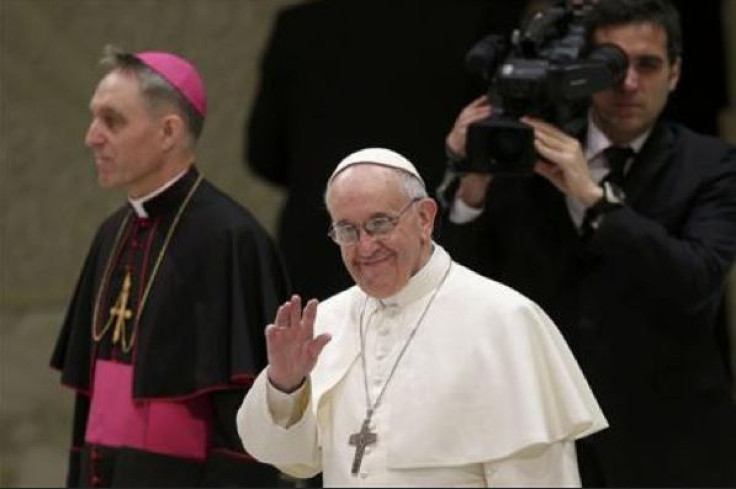Papal Inauguration: Everything You Need To Know About The Ceremony (It’s Not A Coronation)

Hundreds of foreign dignitaries have arrived in Rome to prepare for the "inauguration" (or "installation") of the newly elected pope, Francis, who is the former cardinal of Buenos Aires, Jorge Mario Bergoglio, at St. Peter’s Square.
The ceremony, which will also attract hundreds of thousands of pilgrims to the public square, amounts to a liturgical service within Mass that marks the ecclesiastical investiture of a new pope. It does not officially make him the pope, since that investiture occurred the moment he was elected by the College of Cardinals last week.
"This is more ceremonial. The transition of power has already happened,” Robert Dennis, vice-president of the Canadian Catholic Historical Association and a teaching fellow at Queen’s University in Kingston, told CBC.
During the actual ceremony, Cardinal Jean-Louis Tauran of France will place a woolen cloak featuring six red crosses (the pallium) on the pope’s shoulders, signifying his concurrent pastoral position as Bishop of Rome and the obedience he is to enjoy from the other cardinals.
Then, Angelo Sodano, the dean of the College of Cardinals, will place the Ring of the Fisherman on the pope’s finger; the ring represents St. Peter, the fisherman, who became the first pope.
Then the pope will give a homily, hold mass and subsequently perform the Eucharist and communion.
The inauguration has changed in recent decades - indeed, since the inauguration of Pope John Paul I in August 1978, the new pope has not had a coronation ceremony (a tradition that lasted more than 800 years until 1963, when Pope Paul VI ascended to the papacy). John Paul I, who would serve as Pope for barely more than a month, wanted to eschew the wearing of the papal tiara because the symbolism of the Holy Father as an absolute monarch was outdated.
Dennis added that Francis’ entrance into the square during the inauguration could be historic. In the past, some popes were carried on a wooden throne, while Benedict XVI was transported in on a pope-mobile vehicle. But in light of Francis’ concerns about the poor, he may make a far simpler entrance -- by walking in, among the huge crowds.
"How this pope actually enters is going to be interesting, particularly since this man is reputed to be a man of great simplicity,” Dennis said. “But at the same time there are hundreds of thousands of people who want to catch a glimpse of him.”
The guest list for the inauguration ranges from the ecumenical, including the Archbishop of York, John Sentamu, and Rome’s chief rabbi Riccardo di Segni, to the ridiculous, with the presence of Zimbabwe strongman Robert Mugabe. The former Pope, Benedict XVI, is not expected to attend the inauguration, while the U.S. will be represented by Vice President Joe Biden.
Interestingly, the Pope had asked the president of his native Argentina, Christina Fernandez, not to attend the inauguration, citing that the costs of the trip should instead be used to help the poor. Fernandez, who repeatedly clashed with the pope when he served as archbishop in Buenos Aires over abortion rights and gay marriage, arrived in Rome on Monday.
Leaders of some other faiths who will also attend include Ibrahim Isaac Sidrak, the Coptic Catholic Patriarch of Alexandria, Egypt; and Metropolitan Hilarion, the second-highest person in the Russian Orthodox hierarchy.
Mugabe’s presence will, of course, cause much controversy and embarrassment given that, technically, he is banned from travel to European Union nations over a multitude of alleged misconduct cases, including vote-rigging and human rights abuses in his native Zimbabwe.
Technically, the Vatican is not a part of the EU (thereby exempt from the travel ban), but Mugabe had to land in an airport in Rome, which is Italian soil, thereby marking an infringement of the prohibition.
Reuters reported that Mugabe, his wife Grace and a group of his bodyguards arrived at a Rome airport on Monday and were quickly taken away by van to a hotel on Via Veneto.
Mugabe, 89, has been under the EU travel ban since 2002. A conservative Catholic, Mugabe also visited Italy in 2005 to attend the funeral of Pope John Paul II and also for his beatification ceremony in 2011.
A spokesman for the Vatican declared that it did not explicitly invite Mugabe.
"The Holy See informs everyone that this event is taking place. There are no invitations. There are no privileges and no one is refused. While one country may have problems with someone else, we invite no one. This must be made clear," he said.
Another visitor that may cause headaches for the Vatican is Ma Ying-jeou, the president of Taiwan, whose presence at the ceremony has already sparked outrage from Beijing, which opposes any measure that implies Taiwan is an independent state.
© Copyright IBTimes 2024. All rights reserved.











